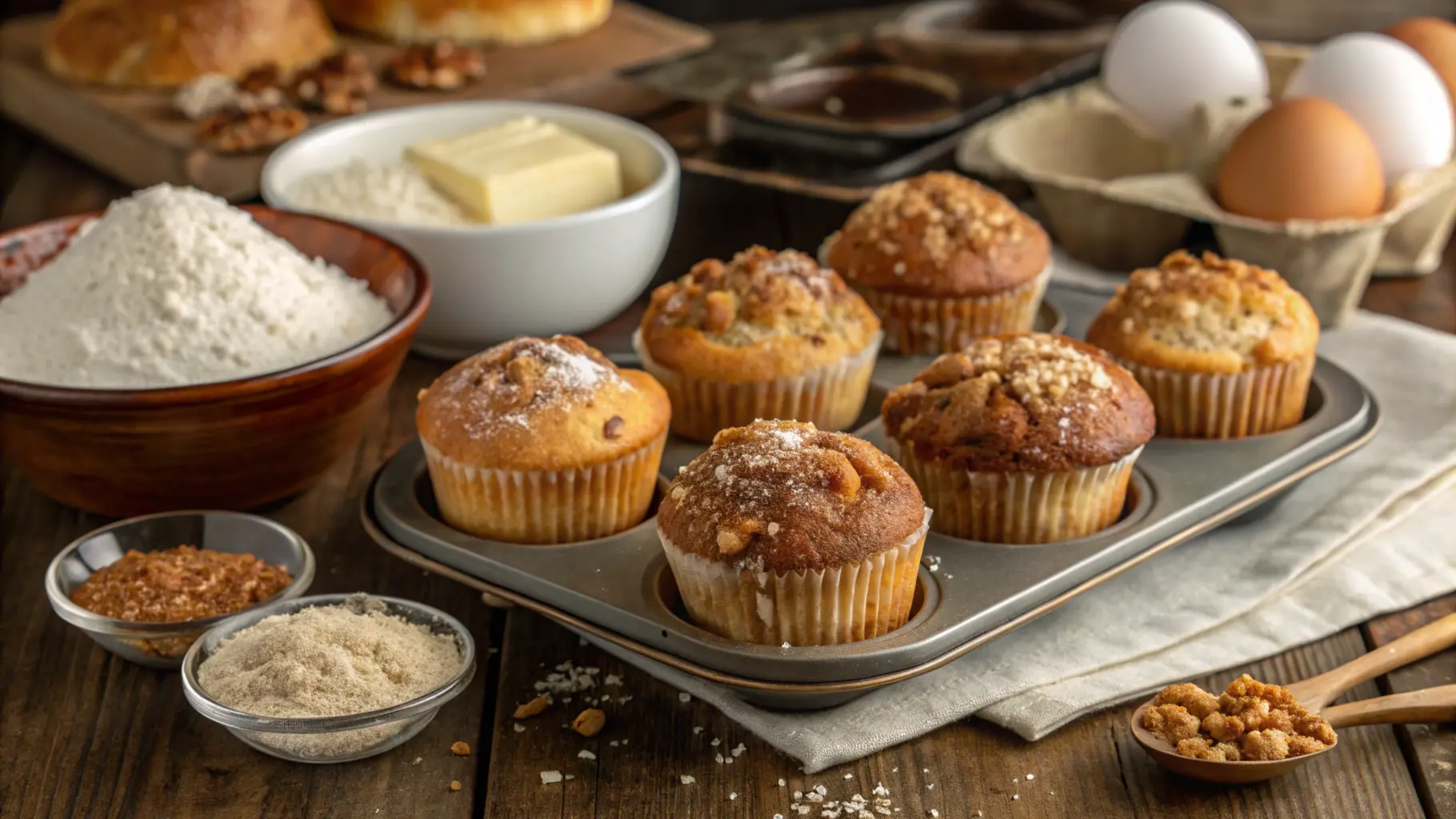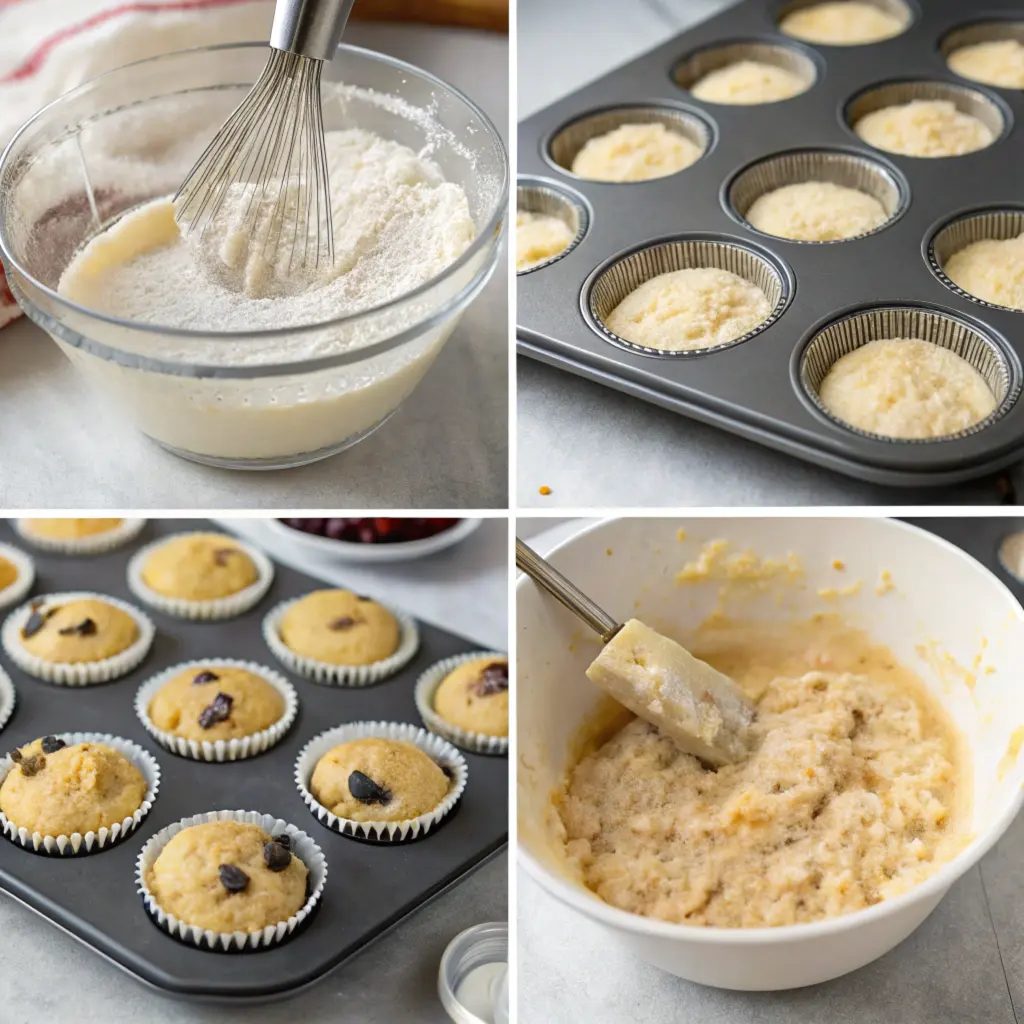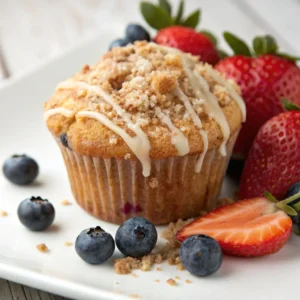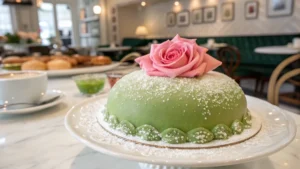Introduction
Who doesn’t love a muffin with a perfectly domed top, soft crumb, and rich, buttery flavor? Bakery muffins have a charm that’s hard to resist. Whether you’re biting into a classic blueberry muffin or a decadent chocolate chip version, there’s something special about the texture and taste that bakery muffins deliver. But what makes them so different from homemade ones?
In this guide, we’ll uncover the secrets behind bakery-style muffins and share tips for making them at home. From the ingredients that give muffins their moist texture to the techniques that create that signature fluffy dome, we’ll cover everything you need to know. Let’s get started!

What Makes Bakery Muffins Special?
Fluffier and Taller Muffins
One of the standout features of bakery muffins is their tall, fluffy tops. Bakeries achieve this by using a combination of the right leavening agents and precise baking techniques. Baking powder and baking soda work together to give the muffins their rise, while professional bakers know the importance of starting with a hotter oven to create that initial lift.
Another trick? The batter consistency. Bakery muffin batters are typically thicker, which helps them hold their shape as they bake. Thicker batters prevent the mix-ins, like fruits or chocolate chips, from sinking to the bottom, ensuring even distribution throughout the muffin.
The Rich Flavor of Bakery Muffins
The flavor of bakery muffins is unmatched, thanks to the use of high-quality ingredients. Bakers don’t skimp on butter, vanilla extract, or fresh fruits, which all contribute to the rich taste. For sweeter muffins, they often use brown sugar, which adds a caramel-like depth of flavor.
Another factor is the balance of sweetness. Bakery muffins are sweet enough to be a treat but not overly sugary, allowing the natural flavors of the ingredients to shine.
These factors combined—texture, flavor, and attention to detail—are what make bakery muffins so irresistible. In the next section, we’ll explore the essential ingredients that contribute to that perfect texture and taste.
Essential Ingredients for Bakery Muffins
The Power of Fat and Sugar
When it comes to bakery muffins, the secret lies in the perfect balance of fat and sugar. Butter and oil play a crucial role in achieving the rich, moist texture that makes bakery-style muffins so irresistible. While butter adds a depth of flavor, oil ensures that muffins remain soft and tender, even after they’ve cooled. For the best results, many recipes combine both.
Sugar isn’t just for sweetness—it’s also key to that golden, caramelized top. Bakeries often use a mix of granulated and brown sugar. The molasses in brown sugar provides a subtle richness and helps lock in moisture, which is why bakery muffins stay fresher longer than homemade ones.
Baking Essentials
Leavening agents like baking powder and baking soda are vital for giving muffins their signature fluffy rise. But they need the right acidic components—like buttermilk, sour cream, or yogurt—to work effectively. These ingredients not only aid in leavening but also add a tangy flavor and extra moisture to the batter.
Eggs are another non-negotiable ingredient. They act as a binder and provide structure while contributing to the overall richness. Using room-temperature eggs helps the batter mix evenly, ensuring that your muffins bake up light and airy.
Next, let’s dive into the step-by-step techniques that make all the difference in creating bakery-style muffins.
Step-by-Step Guide to Baking Bakery Muffins at Home
Creating bakery muffins at home isn’t as hard as it seems! By following these simple steps, you can achieve the tall, fluffy muffins with a rich, moist texture that rival your favorite bakery.

Preparation: Setting the Stage
The key to perfect muffins starts with proper preparation. Preheat your oven to 375°F (190°C) to ensure consistent heat throughout the baking process. For an extra-high dome, start at 400°F (200°C) for the first five minutes, then reduce the temperature for the remaining bake time.
Choose a nonstick muffin tin and line it with sturdy paper liners. These liners not only prevent sticking but also make cleanup effortless. When measuring your ingredients, always be precise. Use the spoon-and-level method for flour to avoid packing it too tightly, as too much flour can lead to dense, dry muffins.
Mixing Techniques for the Perfect Batter
- Combine Dry Ingredients
In a large mixing bowl, whisk together flour, sugar, baking powder, and salt. Whisking not only blends the ingredients but also aerates the flour, giving your muffins a lighter texture. - Prepare Wet Ingredients
In a separate bowl, beat eggs lightly and then whisk in oil (or melted butter), milk, and vanilla extract. Using room-temperature ingredients ensures they combine more smoothly. - Bring Them Together
Gently pour the wet mixture into the dry ingredients. Using a spatula, fold the two together until just combined. The batter should be lumpy—don’t overmix, as this can overdevelop the gluten, resulting in tough muffins. - Add Mix-Ins
If you’re adding blueberries, chocolate chips, or nuts, fold them into the batter at the very end. For fruits like berries, toss them lightly in flour before mixing to prevent them from sinking to the bottom of the muffins.
Baking: The Final Touch
Fill each muffin cup about ¾ full. This gives the batter enough space to rise beautifully without spilling over the edges. Bake the muffins for 18–25 minutes. Check for doneness by inserting a toothpick into the center of a muffin. If it comes out clean or with just a few crumbs, your muffins are perfectly baked!
Once baked, allow the muffins to cool in the pan for 5 minutes before transferring them to a wire rack. This prevents soggy bottoms while allowing the muffins to firm up.
By following these simple yet effective steps, you’ll create bakery muffins that are not only fluffy and flavorful but also visually stunning. Now you’re ready to experiment with your own flavors and toppings to make your muffins even more unique!
Tips for Customizing Bakery Muffins
Creative Flavor Ideas
One of the best things about making bakery muffins at home is the freedom to experiment with flavors. Here are some ideas to help you customize your muffins and make them uniquely yours:

- Fruity Additions: Try adding fresh or dried fruits like blueberries, raspberries, or chopped dried apricots. These bring bursts of flavor and a touch of natural sweetness to every bite.
- Spices for Warmth: A dash of cinnamon, nutmeg, or ginger can elevate simple muffins into warm, comforting treats. Spices work wonderfully in apple, pumpkin, or carrot muffins.
- Citrus Twist: Add a teaspoon of lemon or orange zest to brighten the flavor. This works especially well with blueberry or cranberry muffins.
- Savory Options: For something different, mix in shredded cheese, diced ham, or fresh herbs like chives. These savory muffins make a great breakfast or snack.
Toppings for Bakery Muffins
A topping can make all the difference in transforming your muffins into professional-quality treats. Some ideas include:
- Streusel: A classic crumbly topping made from butter, sugar, and flour that adds texture and sweetness.
- Coarse Sugar: Sprinkle coarse sugar on top for a sparkly, crunchy finish. It’s a simple addition that makes a big visual impact.
- Drizzles and Glazes: A light drizzle of icing or a glaze made from powdered sugar and lemon juice adds a decorative touch and enhances the flavor.
Customizing your bakery muffins is all about being creative and making them your own. For more ideas, check out our article on creative muffin recipes.
Baking Bakery Muffins: Advanced Techniques
Starting with a High Heat
One of the key tricks to achieving the perfect dome on your bakery muffins is starting with high heat. Begin baking at 400°F (200°C) for the first 5 minutes, then lower the temperature to 375°F (190°C) for the rest of the baking time. This initial burst of heat causes the batter to rise quickly, creating that signature dome while locking in moisture.
This technique works best when you use a thicker batter, as it helps the muffins hold their shape during the rapid rise. Avoid opening the oven door during this crucial stage to maintain consistent heat levels.
Timing and Testing for Doneness
Timing is everything when it comes to baking muffins. Typically, muffins take 18–25 minutes to bake, depending on their size and the recipe. To ensure they’re perfectly done, insert a toothpick into the center of a muffin. If it comes out clean or with a few crumbs, they’re ready.
Once baked, let your muffins cool in the tin for about 5 minutes. This allows them to set and makes them easier to remove. Transfer them to a wire rack to cool completely, which helps prevent soggy bottoms.
With these advanced techniques, you can recreate the magic of bakery muffins in your own kitchen, ensuring every batch is picture-perfect and delicious.
Frequently Asked Questions (FAQs)
Why Are Bakery Muffins So Fluffy?
The secret behind fluffy bakery muffins lies in the balance of ingredients and the baking technique. Bakeries often use fresh leavening agents like baking powder and soda, combined with acidic ingredients like buttermilk or yogurt, to create a tender, airy texture. Starting with a high oven temperature for the first few minutes helps muffins rise quickly, giving them that perfect dome.
How Can I Get Bakery-Style Muffins at Home?
To achieve bakery muffins at home, focus on these key steps:
- Start with high-quality ingredients, including fresh baking powder and rich liquids like buttermilk.
- Don’t overmix the batter—lumps are fine and help keep muffins light.
- Fill the muffin cups about ¾ full and start baking at 400°F (200°C) for the first five minutes before reducing the temperature to 375°F (190°C).
What’s the Best Way to Store Bakery Muffins?
Proper storage keeps your muffins fresh and moist for days. Place cooled muffins in an airtight container with a paper towel underneath to absorb any extra moisture. They can be kept at room temperature for up to 3 days. If you want to store them longer, wrap each muffin individually in plastic wrap and freeze them. Simply reheat in the oven for that bakery-fresh feel.
For more delicious recipes and baking tips, check out our Makouri Recipes’ baking guides. Happy baking!
Conclusion
Why Bakery Muffins Are Worth the Effort
Baking bakery muffins at home may require a bit more attention to detail, but the results are well worth it. From their tall, fluffy tops to their rich and tender texture, these muffins offer the perfect blend of flavor and presentation. Whether you’re making them for a weekend brunch, a grab-and-go breakfast, or a sweet snack, they’re guaranteed to impress.
Mastering the art of bakery muffins means understanding the role of high-quality ingredients, proper mixing techniques, and strategic baking methods. Once you’ve nailed the basics, you can experiment with flavors, mix-ins, and toppings to make your muffins truly your own.
Final Call to Action
Ready to start baking? Grab your mixing bowls, preheat that oven, and put these tips into action. Whether you stick to classic recipes or try new creative twists, you’ll have muffins that rival those from your favorite bakery. For more baking inspiration, check out our Makouri Recipes’ baking guides. Happy baking!



2 thoughts on “Bakery Muffins: Secrets to Perfectly Fluffy and Moist Muffins”